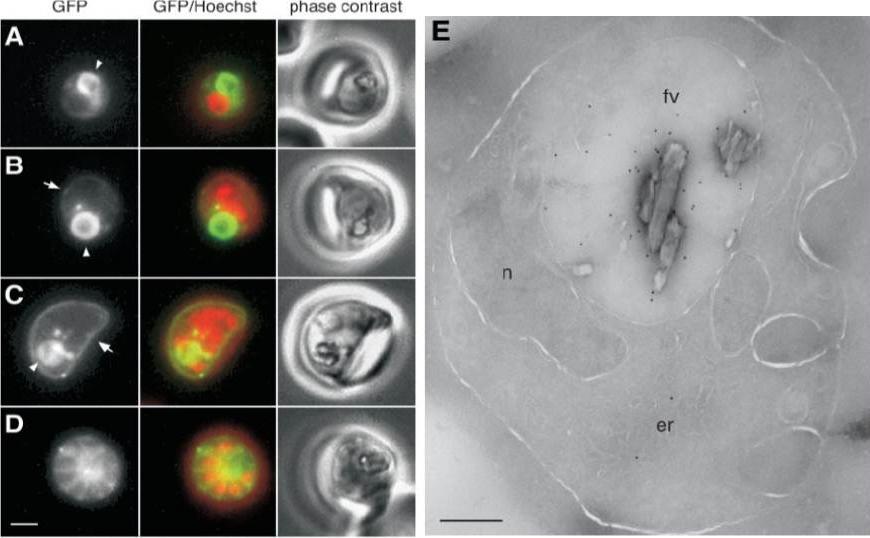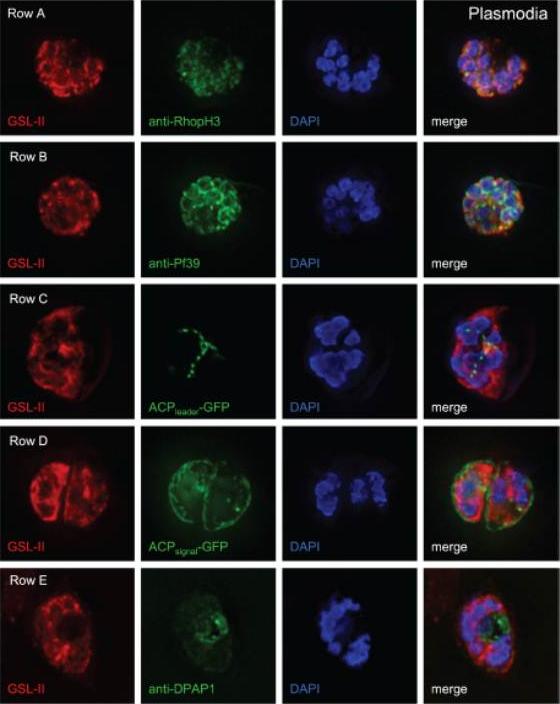PVX_091465 dipeptidyl aminopeptidase 1, putative (DPAP1)
Disruptability [+]
| Species | Disruptability | Reference | Submitter | |
|---|---|---|---|---|
| P. berghei ANKA |
Possible |
RMgm-810 | Imported from RMgmDB | |
| P. berghei ANKA |
Refractory |
PlasmoGEM (Barseq) | PlasmoGEM | |
| P. falciparum 3D7 |
Refractory |
15304495 | Theo Sanderson, Wellcome Trust Sanger Institute | |
| P. falciparum 3D7 |
Possible |
USF piggyBac screen (Insert. mut.) | USF PiggyBac Screen | |
Mutant phenotypes [+]
| Species | Stage | Phenotype | Reference | Submitter |
|---|---|---|---|---|
| P. berghei ANKA | Asexual |
Difference from wild-type |
RMgm-810
Blood stages show a reduced growth rate (and a normal hemozoin production) |
Imported from RMgmDB |
Imaging data (from Malaria Metabolic Pathways)

Localization of DPAP1 to the food vacuole and the parasitophorous vacuole. A–D, fluorescence microscopy of live parasites expressing DPAP1-GFP. A, trophozoite. B, ~2N schizont. C, ~8N schizont. D, 8N segmented schizont. In the center column fluorescence from GFP is green and that from nuclear stain Hoechst 33342 is red. The food vacuole is indicated with arrowheads in the GFP panels of A–C, and the parasitophorous vacuole is indicated with arrows in B and C. Fluorescent spots in B and C may be vesicular structures involved in transport of DPAP1-GFP to the food vacuole. Bar, 2 mm. E, immunogold labeling of an F9 parasite with anti-DPAP1 antibody. fv, food vacuole; er, endoplasmic reticulum; n, nucleus. Bar, 400 nm.Klemba M, Gluzman I, Goldberg DE. A Plasmodium falciparum dipeptidyl aminopeptidase I participates in vacuolar hemoglobin degradation. J Biol Chem. 2004 279:43000-7.
See original on MMP
Deconvolving micrographs of Plasmodium-infected RBCs show that GSL-II, which binds to Plasmodium N-glycans, colocalizes with rhoptries (row A) and the ER (row B) but does not colocalize with apicoplasts (row C), the parasitophorous vacuole (row D), or the food vacuole (row E). In each case GSL-II is labeled red with Alexafluor 594, while antibodies labeled green with Alexafluor 488 are against RhopH3 (rhoptries), Pf39 (ER), and food vacuole (DPAP1). Alternatively, GFP is targeted to apicoplasts (ACPleader-GFP) and the parasitophorous vacuole (ACPsignal-GFP). Control experiments with anti-GFP antibodies show that both apicoplasts and parasitophorous vacuoles are accessible to exogenous probes. The nature of the glycosylated proteins is not knownBushkin GG, Ratner DM, Cui J, Banerjee S, Duraisingh MT, Jennings CV, Dvorin JD, Gubbels MJ, Robertson SD, Steffen M, O'Keefe BR, Robbins PW, Samuelson J. Suggestive evidence for Darwinian Selection against asparagine-linked glycans of Plasmodium falciparum and Toxoplasma gondii. Eukaryot Cell. 2010 9:228-41.
See original on MMPMore information
| PlasmoDB | PVX_091465 |
| GeneDB | PVX_091465 |
| Malaria Metabolic Pathways | Localisation images Pathways mapped to |
| Previous ID(s) | Pv091465 |
| Orthologs | PBANKA_0931300 , PCHAS_0913000 , PF3D7_1116700 , PKNH_0914400 , PVP01_0917300 , PY17X_0933300 |
| Google Scholar | Search for all mentions of this gene |